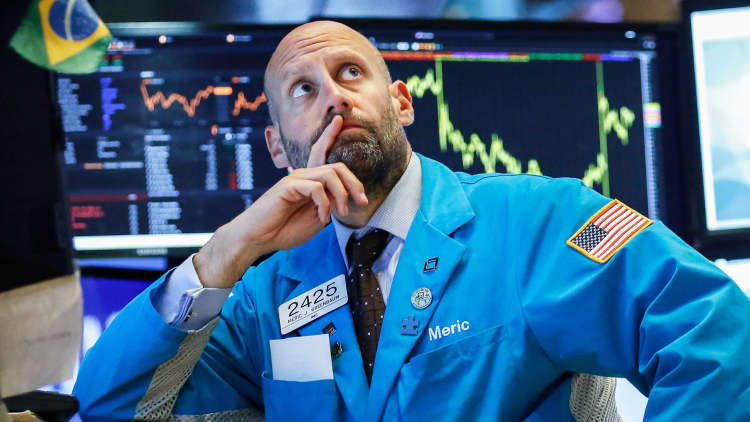Investors again rushed for the safety of government bonds and dumped stocks on Wednesday, exacerbating the August exodus away from risk assets as traders around the world settled in for a U.S.-China trade war without an end in sight.
The flight to safety sent the yield on the 10-year Treasury note — used as a benchmark for mortgage rates and auto loans — falling to a low of 1.595%, the lowest since autumn 2016. The yield on the 30-year Treasury bond bottomed around 2.12%, near its all-time low reached in 2016. Yields pared some of their declines later in the session, but held steady near multiyear lows.
The 10-year Treasury rate is about 40 basis points below its level one month ago, down more than 35 basis points in August alone and representing a sizable move for the relative stable U.S. bond market. The yield ended July above 2%.

Bond yields move inversely to their prices; yields fall when investors demand Treasurys.
The head-turning moves in the bond market weren't isolated to the United States, however, as rates in Germany and the United Kingdom clinched all-time lows across the board on Wednesday.
The yield on the German 10-year bund hit a new all-time low of -0.6% while the 30-year bund also hit a record at -0.137%. The 2-year German yield touched -0.849%.
The U.K. 10-year and 30-year yields both hit record lows at 0.432% and 1.081%, respectively.
The U.S. Treasury yield curve also exacerbated its recent flattening and inversion, with the spread between the yield on the 3-month Treasury bill and that of the 10-year Treasury note close to -40 basis points. The spread between the 2-year Treasury yield and the 10-year yield, a longtime recession gauge, hit a low of 7.4 basis points, its lowest level since June 6, 2007.
"The flattening in 2s/10s should be expected in a world of rising global macro risk, coupled with falling forward inflation expectations," Jon Hill, rates strategist at BMO Capital Markets, said in an email to CNBC. "There is an element of fear here that the Fed won't cut as much as necessary to keep the cycle going and maintain inflation near 2%. This keeps front-end rates elevated while long-tenor yields fall."
"However, we think eventually this gives way to a more aggressive Fed cutting campaign – even a 'mid-cycle' move could easily be in the 100 bp to 125 bp magnitude," Hill added.
The Wednesday plunge in the 10-year rate added to a marked fall for the month as fixed-income traders resigned themselves to a U.S.-China trade fight without a clear resolution in sight.
Official negotiations between Washington and Beijing broke down in recent weeks after President Donald Trump announced that the U.S. would slap new tariffs on Chinese goods starting Sept. 1. China, in turn, threatened retaliatory action and allowed their currency to weaken against the dollar, triggering a wave of angst across Wall Street that the two nations could fall into a currency war in an effort to boost domestic exports.
China's central bank set the official midpoint reference for the yuan at 6.9996 on Wednesday, slightly weaker than what markets anticipated. Its level against the dollar is important given that the lower the currency, the cheaper Chinese products will be when exported.
This comes after the United States declared that China was a currency manipulator – a step that hadn't been taken since the Clinton administration and escalated tensions among the two countries.
The plummet in rates on Wednesday also came after central banks in India, New Zealand and Thailand surprised investors in overnight trading with aggressive rate cuts, joining a growing global shift toward easier monetary policy.
The Reserve Bank of New Zealand slashed its official cash rate by 0.5 percentage point to 1%, a steeper reduction than what economists had forecast. The Reserve Bank of India lowered its benchmark lending rate by 0.35 percentage point to 5.4%, the central bank's fourth rate reduction of 2019.

"Overnight many central banks cut rates, including New Zealand and this is dragging all yields lower," Jim Caron, managing director of global fixed income at Morgan Stanley Investment Management, told CNBC. "The Fed is lagging this cycle, so it is no surprise" to see the yield curve continue to invert.
The Fed's decision in July to only cut by 25 basis points "was a policy mistake and they should have gone 50bps," he added. "The largest central bank in the world, the Fed, needs to lead not follow. It is important they get out ahead of the risks associated with a trade war."
On the data front, consumer credit figures are released at 3 p.m. ET. Traders will monitor a speech by Chicago Fed President Charles Evans at 9:30 a.m. ET. Also, the U.S. Treasury is set to auction $27 billion in 10-year notes.
Treasurys
--- CNBC's Joanna Tan contributed to this report


